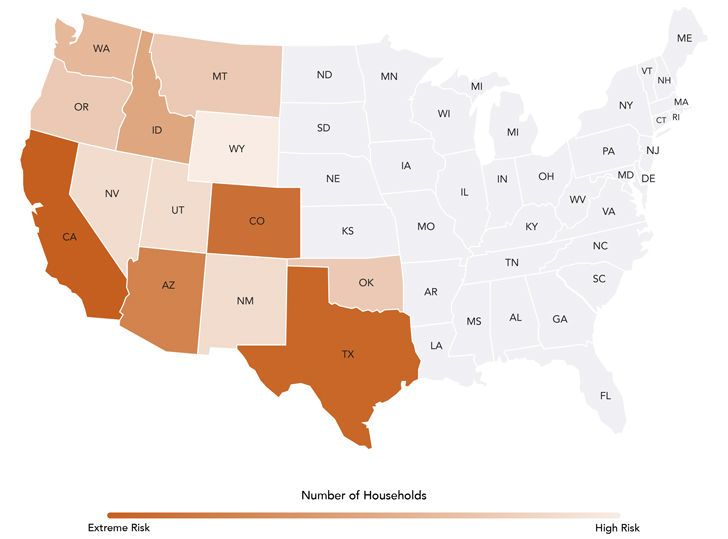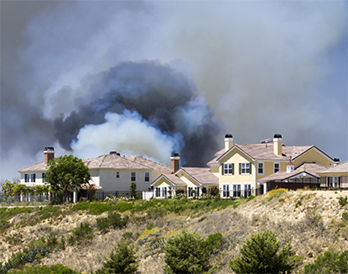Reduce Your Wildfire Risk
In the past, wildfires were most likely to happen between May and October. Now, fires can occur any time of the year and are burning more intensely amid extreme conditions. What the U.S. Forest Service once characterized as a four-month-long fire season now lasts six to eight months of the year, with fires even in winter months becoming part of the norm.
Most wildfires occur in Western states where heat, drought and frequent thunderstorms create ideal conditions for outbreaks. According to Verisk’s Wildfire Risk Analysis,1 4.5 million U.S. homes are identified at high or extreme risk for wildfires, with more than 2 million in California alone.
But fire isn’t just a problem out west. The warming planet raises the risk of major fire damage in other areas of the country, as well.1

Number of properties at high to extreme risk from wildfire
| State/Province | Number of Properties* |
|---|---|
| California | 2,040,600 |
| Texas | 717,800 |
| Colorado | 373,900 |
| Arizona | 242,200 |
| Idaho | 175,000 |
| Washington | 155,500 |
| Oklahoma | 153,400 |
| Oregon | 147,500 |
| Montana | 137,800 |
| Utah | 136,000 |
| New Mexico | 131,600 |
| Nevada | 67,100 |
| Wyoming | 36,800 |
Prevent wildfire damage in and around your home
A single spark from a cigarette, campfire or downed power line can ignite a blaze that could last for weeks. And most structures that burn in a wildfire are ignited by embers carried downwind ahead of the fire. Take these steps to help keep yourself, your family and your property safe.

Make your home wildfire-ready
- Wrap your home with fire-resistant shingles and siding if possible.
- Cover attic vents with 1/8-inch metal screens.
- Regularly clean debris from gutters and downspouts. Leaves, twigs and litter act as fuel for fires caused by wind-borne embers.
- Create defensible zones around your house.
- Plant fire-resistant landscaping.
Download the free IBHS Wildfire Ready Virtual app for a quick and easy way to check if you're wildfire-ready.
Plan ahead
- Stock enough emergency supplies for 72 hours. Learn more
- Download the Emergency App for iPhone (Start here) or Android (Start here).
- Know your insurance coverage and where to find your policies. Start here
- Take photos or video of each room to document your belongings.
- Store contact info for emergency services, family members, friends, neighbors and your insurance company in your phone.
- Know your community’s warning system and the emergency shelter locations.
- Plan and practice two escape routes and specify a meeting place.
- Develop a family communication plan and share it with others.
If a wildfire is coming
- Report it by calling 911.
- Ensure gutters are clear of debris.
- Close windows in your house and car to keep out burning embers.
- Fill pools, hot tubs, garbage cans or other large containers with water.
- Connect garden hoses for firefighters to use to put out fires on rooftops.
- Bring outdoor furniture, wooden containers and any other combustibles inside.
- Keep your cellphone and other electronic devices adequately charged, and have a backup battery.
- Protect all important documents in a fireproof safe.
- Park your car facing your escape route and evacuate immediately if told to do so.
- If you must evacuate, unplug appliances and turn off utilities, including natural gas or propane. Take your emergency supplies and important documents; let loved ones know where you plan to go.
After a wildfire
- Let family members know you’re safe.
- Be prepared for potential flooding, since the ground might be charred and lack vegetation.
- Return home only when authorities say it’s safe.
- Be careful when entering burned areas, since fires may flare up without warning.
- Maintain a fire watch for several hours after the first has passed; look for signs of smoke or embers throughout your property.
- Report serious structural damage, downed power lines and gas leaks to local officials.
- Contact us as soon as possible to report damage and file a claim. Start here
- Restock your emergency supplies.
- When rebuilding or repairing damage, invest in fire-resistant building materials to avoid repeat problems.
Your Policy, Policy Declarations or Amended Declarations in effect on the date of loss is the primary source of reference for your coverage, coverage limits and deductible amounts.
This inclusion of non-Amica companies, products, services or statement herein (“Third-Party Content”) is for general informational purposes only and does not constitute a recommendation or endorsement by Amica Insurance. Policies, views, opinions or positions of Third-Party Content expressed herein are those of the authors and do not necessarily reflect the policies, views, opinions or positions of Amica Insurance. Amica Insurance makes no warranties, express or implies, as to the accuracy and reliability of Third-Party Content.
This content may contain helpful tips, explanation and advice. Your use of this information is voluntary and may not be effective in every circumstance. Amica encourages you to use good judgement and put safety first.
For more information on our editorial process and content standard, take a look at our editorial guidelines.
